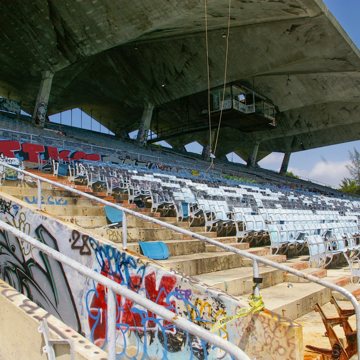Miami’s penchants for dramatic architecture and spectacular entertainment have produced numerous fascinating buildings, but perhaps none as well-loved and ill-fated as Miami Marine Stadium. When the building opened in December 1963, it was the first facility of its kind—an arena intended specifically for watching motorboat races—built in the United States. Designed by Hilario Candela, a 28-year-old Cuban émigré in the office of Pancoast, Ferendino, Grafton, Skeels and Burnham, Marine Stadium is remarkable for its boldly cantilevered concrete roof and stunning site planning. However, damage inflicted on the roof by Hurricane Andrew has left the building unusable since 1992, and it currently awaits structural rehabilitation.
Marine Stadium is one of a number of recreational facilities lining Rickenbacker Causeway, which was envisioned by Dade County Parks Commissioner Charles Crandon and laid out by landscape architect William Lyman Phillips in 1947. An alumnus of the Olmsted Brothers firm in Boston, Phillips designed several of South Florida’s most popular public landscapes, including Fairchild Tropical Botanic Garden and Matheson Hammock Park. Marine Stadium is the most monumental of the causeway’s amenities, which include Virginia Key Beach Park (1945), laboratories for the University of Miami’s School of Marine Sciences (1953), and the Miami Seaquarium (1955). The stadium’s dramatic cantilevered roof is balanced on the other side of the road by the delicate tracery of Buckminster Fuller’s geodesic dome at the Seaquarium (1960).
The idea for a public boat racing facility originated in the Miami City Commission, which hired Ralph H. Burke Engineers and Architects to conduct a feasibility study and prepare a master plan for the project in 1962. The firm, based in Chicago, noted the long tradition of public boat racing spectacles in the waters off Miami, dating to events organized by Miami Beach founder Carl Fisher in the 1920s. The master plan included space for the grandstand, a floating concert stage, restaurants, boat slips, and parking, as well as the design of the water course in a newly constructed basin carved out of the mangroves on the west side of Virginia Key, facing downtown. The U-shaped basin, which resembles an aquatic version of the Circus Maximus (popularized in the 1959 film Ben Hur), is over a mile in length and opens onto a panoramic view of the downtown Miami skyline.
Candela set Marine Stadium’s grandstand on the north side of the causeway, so that spectators would have their backs to the sun while watching boat races in the basin. The 6,600-seat grandstand straddles the edge of the basin so that it is partly rooted in the earth (albeit reclaimed land) and partly hovering over the water. The movement from land to water is celebrated repeatedly in the spectator’s procession from ticket booth to seat. The side facing the causeway greets visitors with a zig-zagging row of diagonal struts that reach up to the vertices of the folded-plate canopy, and form a colonnade-like entry to the stadium. The first hint of the water comes while ascending the main ramps, which climb slowly through openings in the ranks of seats, allowing glimpses of the water with the seating perched delicately above it. From there, the dark shade of the landside entry gives way to the open expanse of the boat basin, framed by the dramatic cantilever of the tribune roof above.
As Jean-François Lejeune has written, Candela knew a great deal about dramatic concrete structures built in Latin America during the previous decade. He was a distant relative of Felix Candela, and had seen the older architect’s work on the Bacardi Rum Corporation’s vaulted bottling plant and other structures in Tultitlán, Mexico. Candela had also met Pier Luigi Nervi, and was familiar with the Italian engineer’s Tropicana Nightclub in Havana. The ready availability of concrete in Miami (the region is built almost entirely on calcium-rich stone, an essential ingredient in concrete) and the city’s strong cultural ties to Latin America helped Candela convince city officials to approve the design of the grandstand, which was engineered by Norman Dignum Associates Engineers.
During its two decades of abandonment, Marine Stadium has become a magnet for graffiti artists. Spray paint covers much of the building’s concrete surfaces, and its deep overhangs have helped to preserve the vibrant hues of the illicit art. The structure may be the most significant South Florida site for street art outside the Wynwood Arts District. Yet the quality of the graffiti exhibited at Marine Stadium provides a conundrum for preservationists, who are divided on whether to conserve the building in its current state or to return it to its original state.
Preservation efforts spearheaded by the Dade Heritage Trust through its Friends of Marine Stadium initiative have resulted in the building’s historic designation from the City of Miami (2008), its listing on the National Trust for Historic Preservation’s Eleven Most Endangered Sites List, and its addition to the World Monuments Fund Watch List (both in 2009). A new engineering study commissioned by the Trust is the first step in a restoration process that will include necessary structural repairs and replacement of seating, utilities, and ancillary buildings.
References
Lejeune, Jean-François. “Miami’s Marine Stadium.” In Miami Modern Metropolis: Paradise and Paradox in Midcentury Architecture and Planning, edited by Allan T. Shulman, 352-357. Miami, FL: Bass Museum of Art, 2009.
Shulman, Allan T., Randall C. Robinson, and James F. Donnelly. Miami Architecture: An AIA Guide Featuring Downtown, the Beaches, and Coconut Grove. Gainesville, FL: University Press of Florida, 2010.

